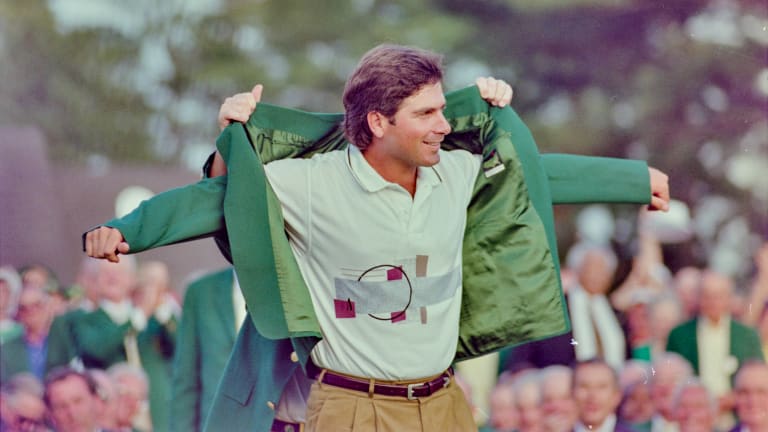
Thirty Years Later, Fred Couples' Green Jacket Win Still Resonates

It’s the lay of the land that blows the minds of so many first-time visitors to Augusta National Golf Club, where the staggering beauty and boisterous terrain simply can’t be visually replicated, not even by the latest 5K televisions.
The club’s institution of a ticket lottery in 2012 has granted tournament access to thousands of golf fans who never would’ve had a prayer of attending a Masters otherwise. It ranks as one of the best decisions the greenjackets have ever made.
What those newcomers quickly realize is that the course was built on land far more dramatic than TV indicates. The best example can be found in the downhill disposition of the 10th fairway, which curves sharply to the left until it eventually wanders behind a wall of Georgia pines like an emerald-carpeted version of the Yellow Brick Road. Or from the view from behind the 18th tee, where those same towering trees form a narrow driving chute before widening as players begin the steep climb to the final green.
Thirty years have passed since I covered my first Masters, a week that played a huge role in my wanting to write about golf on a full-time basis instead of dealing with pro athletes in mainstream sports. The 1992 affair was a great place to start. It wasn’t nearly the earth-shaking occasion that occurred at Augusta National five years later, when Tiger Woods turned the game upside-down with a 12-stroke triumph in his first major appearance as a pro.
Given how next week marks the 25-year anniversary of Woods' landmark achievement, you won’t have any trouble finding articles attempting to provide fresh perspective on Woods' historic performance, but 1992 was no slouch as big tournaments go, either. Fred Couples beat Raymond Floyd by two shots for his lone major title, a victory that validated his vast (and largely unfulfilled) potential and reaffirmed his spot atop the Official World Golf Ranking.
It’s worth noting that pro golf’s competitive landscape had a very different look three decades ago. Couples was the first American to win the Masters since Larry Mize in 1987, ending the longest such stretch in tournament history. The four previous winners all had come from the United Kingdom, marking the height of an era when foreign players had established themselves as the game’s dominant force. That made Couples a hero of sorts, a hugely popular champion, but three of the four Masters that followed were also claimed by non-Americans.
Australian Craig Parry, who held sole possession of the 54-hole lead by a stroke over Couples, stumbled to a closing 78, courtesy of seven three-putts and what he considered untoward behavior from Augusta National’s famously hospitable galleries. Indeed, there were plenty of folding chairs creaking as patrons began moving toward the next hole the instant Couples putted out, but nobody drops from first to T13 due to a bit of crowd migration.
What has stuck with me over the 30 years isn’t just the immaculate nature of the golf course or the obvious prestige of the tournament, but the atmosphere generated by the 40,000 or so folks who make the pilgrimage from Tuesday onward. It feels like a big deal the moment you walk through the gates. To that end, the club’s membership has done a wonderful job of maintaining an anachronistic environment year after year, shunning overt commercialism and preserving its traditional values — an old-fashioned elixir that continues to separate the Masters from any other big sporting event on the calendar.
Even CBS, a target of criticism for its weekly coverage of the PGA Tour, the network’s staid collection of on-air talent rarely fails to deliver during the second week in April. Lead analyst Nick Faldo’s usual assortment of non sequiturs suddenly turn into whole thoughts with relevant strategic insight. Ian Baker-Finch turns down the dial on his happy-talk tendencies. Anchor Jim Nantz’s reverential treatment of all things big and small becomes a suitable component when the game’s largest viewing audience is absorbing every word.
A few years after Nantz’s longtime friend slid his arms into a green blazer, Couples and former caddie Joe La Cava were engaged in one of their typical brothers-from-another-mother ribbing sessions on the Augusta National practice green. The 1992 champ clearly was in a good mood before heading to the first tee, as La Cava was pecking at him pretty hard, until Couples suddenly looked up to remind his sidekick that he could fire him on the 13th green later that afternoon, just because he felt like it.
“No you can’t," La Cava replied. “You couldn’t even get your bag up to the clubhouse."
Bad back and all, Couples was genuinely amused. It’s all smiles in Georgia on the second week in April.
More 2022 Masters Coverage on Morning Read:
- Tiger Woods Plays Augusta National as Speculation Swirls
- 30 Years Later, Fred Couples' Green Jacket Still Resonates
- Golf's (Augusta) National Treasure: 99-Year-Old Jackie Burke
- Updated Field List for 2022 Masters
- This Teenager is Masters' Most Improbable Participant
- A Half-Century of Masters Stories From One Family
- Memorable Moments, Key Stats On Par-4 11th Hole at Augusta